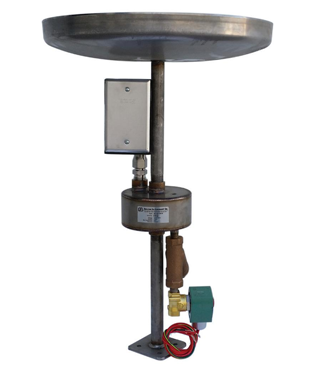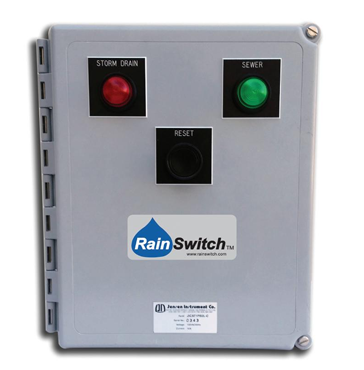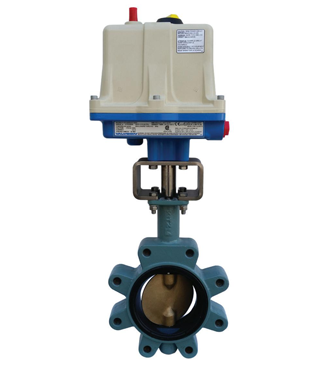Resources
Rainwater Diversion Strategies
Submitted by Dave Molinari || Valin Corporation
Rainwater quality can vary depending on the surface area it falls on. Initially, rainwater can collect oils, contaminants, and chemicals as it touches the ground. However, as it continues to fall, it picks up fewer foreign substances, resulting in cleaner water. As a result, the first 1/10th of an inch of rainwater requires different treatment than the rest. Fortunately, technology exists to treat the initial rainwater, and it has been utilized in certain parts of the country for some time. However, as more people become aware of this functionality, its applications are gaining popularity all across the country.
The concept of diverting portions of rainwater was first developed in the late 1960s in Los Angeles, where the unique geography of the area causes water to be squeezed from the atmosphere as storms move in from the ocean and meet the elevated land. Although rain is infrequent in this region, it is crucial to capture as much of it as possible for future use in groundwater basins. However, during storm events, the existing wastewater system can become overwhelmed. All flushable water runs through a wastewater treatment facility before being discharged into the ocean. The influx of freshwater from a storm event, known as clean water incursion, can disrupt the wastewater treatment process, leading to an imbalance in the system.
The challenge at hand was not an easy one to solve. The objective was to figure out how to separate a portion of the rainwater and send it to the wastewater treatment plant while directing the remaining water to the groundwater basins or ocean. To address this problem, a specialized technology was developed. The technology is designed specifically for controlling drain diversion and is comprised of three key components: the detection device, pilot stations, and valves. The detection device was created to identify when 1/10th of an inch of rainfall occurs. This amount of rainfall typically contains high levels of contaminants and bacteria, making it unsuitable for the groundwater basins and requiring treatment before being discharged into the ocean.
To ensure durability, the detection device must be built using sturdy materials that can withstand harsh conditions. Rainwater is collected in a chamber, and a conductive level sensor detects the volume when it reaches 1/10 of an inch. This signal is then sent to a pilot station.


Mounted inside the pilot station is a level controller that changes state. It sends a small current to the probe, and when the water comes into contact with the probe, the circuit is completed, and the contacts switch in the controller. Most importantly, this process is highly reliable.
The pilot station operates in two modes: normal mode and divert mode. In normal mode, when it is not raining, the valve is set to direct the flow to the sewer system. An automatic timer opens the solenoid valve for 15 minutes every 10 hours. When it is raining and the pilot station is in divert mode, the valve directs the water to the appropriate destination, either the ground water basins or the sewer system for treatment.
Once rainfall reaches the designated threshold, the pilot station is switched to divert mode, triggering the controller to alter the valve's state and direct the rainwater to the storm drain system. After 10 hours, the automatic timer resets the detection system, causing the valve to return to normal mode and redirect the flow to the sewer system until the next 1/10th of an inch is detected. This cycle repeats until the rainfall stops and the system returns to normal mode.
In most cases, butterfly or ball valves are utilized alongside a clarifier for the diversion process. However, there are instances where a sump pump can be employed to regulate the flow to the sewer or storm drain, depending on the plumbing arrangement of the drainage system. The best design for the situation at hand must be determined.

In the southern United States, cisterns have become increasingly popular, especially in areas where there are mandates for parking lots to have a cistern tank for capturing water runoff for irrigation purposes. However, it can be challenging to determine when the tank is full and requires diverting water elsewhere to avoid street flooding and clogging in the storm drain. Fortunately, water diversion control technology can be utilized to address this challenge, ensuring that excess water is directed to the appropriate location.
The RainSwitch™ is made of stainless steel to ensure long life against harsh environments. The RainSwitch™ is designed with a 14” funnel to collect the falling rain. It is connected to a diversion system, directing the subsequent run off to the storm drain system. The diversion system typically consists of a butterfly/ball valve adjacent to a clarifier, or sometimes a sump pump is used which controls the flow to the sewer or storm drain. The system design depends on the plumbing arrangement of your drainage system.
Valin provides 2- & 3-Way Butterfly & Ball Valves for diversion of flow from sewer to the storm water piping which include wiring schematics and installation recommendations with RainSwitch™.
It is crucial to explore all options available for rainwater diversion, whether to comply with city ordinances or to utilize the collected rainwater for various purposes. Awareness of available technology can help ensure that rainwater is appropriately managed and diverted to prevent flooding and contamination.
Article featured in Filtration News Magazine
The concept of diverting portions of rainwater was first developed in the late 1960s in Los Angeles, where the unique geography of the area causes water to be squeezed from the atmosphere as storms move in from the ocean and meet the elevated land. Although rain is infrequent in this region, it is crucial to capture as much of it as possible for future use in groundwater basins. However, during storm events, the existing wastewater system can become overwhelmed. All flushable water runs through a wastewater treatment facility before being discharged into the ocean. The influx of freshwater from a storm event, known as clean water incursion, can disrupt the wastewater treatment process, leading to an imbalance in the system.
The challenge at hand was not an easy one to solve. The objective was to figure out how to separate a portion of the rainwater and send it to the wastewater treatment plant while directing the remaining water to the groundwater basins or ocean. To address this problem, a specialized technology was developed. The technology is designed specifically for controlling drain diversion and is comprised of three key components: the detection device, pilot stations, and valves. The detection device was created to identify when 1/10th of an inch of rainfall occurs. This amount of rainfall typically contains high levels of contaminants and bacteria, making it unsuitable for the groundwater basins and requiring treatment before being discharged into the ocean.
To ensure durability, the detection device must be built using sturdy materials that can withstand harsh conditions. Rainwater is collected in a chamber, and a conductive level sensor detects the volume when it reaches 1/10 of an inch. This signal is then sent to a pilot station.

RainSwitch™

Pilot Station
Mounted inside the pilot station is a level controller that changes state. It sends a small current to the probe, and when the water comes into contact with the probe, the circuit is completed, and the contacts switch in the controller. Most importantly, this process is highly reliable.
The pilot station operates in two modes: normal mode and divert mode. In normal mode, when it is not raining, the valve is set to direct the flow to the sewer system. An automatic timer opens the solenoid valve for 15 minutes every 10 hours. When it is raining and the pilot station is in divert mode, the valve directs the water to the appropriate destination, either the ground water basins or the sewer system for treatment.
Once rainfall reaches the designated threshold, the pilot station is switched to divert mode, triggering the controller to alter the valve's state and direct the rainwater to the storm drain system. After 10 hours, the automatic timer resets the detection system, causing the valve to return to normal mode and redirect the flow to the sewer system until the next 1/10th of an inch is detected. This cycle repeats until the rainfall stops and the system returns to normal mode.
In most cases, butterfly or ball valves are utilized alongside a clarifier for the diversion process. However, there are instances where a sump pump can be employed to regulate the flow to the sewer or storm drain, depending on the plumbing arrangement of the drainage system. The best design for the situation at hand must be determined.

Valve
Are There Applications Outside of a City Like Los Angeles?
Absolutely. This technology can be applied in various places across the country – for instance, in heavily trafficked patio areas of large residential or commercial buildings, where water runoff is diverted to the sewer system or the building's rain gutter system. Incorporating this water diversion technology can ensure that the first 1/10th of an inch heads to the sewer system while the rest is utilized for the building's intended purposes.In the southern United States, cisterns have become increasingly popular, especially in areas where there are mandates for parking lots to have a cistern tank for capturing water runoff for irrigation purposes. However, it can be challenging to determine when the tank is full and requires diverting water elsewhere to avoid street flooding and clogging in the storm drain. Fortunately, water diversion control technology can be utilized to address this challenge, ensuring that excess water is directed to the appropriate location.
The RainSwitch™ is made of stainless steel to ensure long life against harsh environments. The RainSwitch™ is designed with a 14” funnel to collect the falling rain. It is connected to a diversion system, directing the subsequent run off to the storm drain system. The diversion system typically consists of a butterfly/ball valve adjacent to a clarifier, or sometimes a sump pump is used which controls the flow to the sewer or storm drain. The system design depends on the plumbing arrangement of your drainage system.
Valin provides 2- & 3-Way Butterfly & Ball Valves for diversion of flow from sewer to the storm water piping which include wiring schematics and installation recommendations with RainSwitch™.
It is crucial to explore all options available for rainwater diversion, whether to comply with city ordinances or to utilize the collected rainwater for various purposes. Awareness of available technology can help ensure that rainwater is appropriately managed and diverted to prevent flooding and contamination.
Article featured in Filtration News Magazine
A lesson for me is that I need to involve you earlier in the program.
You were tireless in your support and it will not be forgotten!
Latest from Valin's Blog
The NIST Chemistry WebBook contains a great deal of information regarding the properties of a broad range of chemicals and is helpful for those who deal with chemical processes.In this article, Jon Monsen has outlined the procedure for finding the actual density of a gas using the WebBook.
